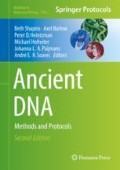Abstract
The majority of DNA recovered from ancient remains is derived from organisms that colonize the remains post-mortem, such as soil microbes, or from contaminants, such as DNA from living humans. Additionally, some ancient DNA research projects aim to target specific genomic regions, such as mitochondrial genomes or variable single nucleotide polymorphisms (SNPs). To overcome the challenge of targeting specific fragments of DNA from within a complex DNA extract, methods have been developed to enrich ancient DNA extracts for target DNA relative to nontarget DNA. This chapter describes a method for target DNA enrichment that uses hybridization to biotinylated RNA baits to capture and amplify specific ancient DNA fragments from within the pool of extracted fragments.
Access this chapter
Tax calculation will be finalised at checkout
Purchases are for personal use only
References
Green RE, Krause J, Briggs AW et al (2010) A draft sequence of the Neandertal genome. Science 328:710–722
Reich D, Green RE, Kircher M et al (2010) Genetic history of an archaic hominin group from Denisova Cave in Siberia. Nature 468:1053–1060
Skoglund P, Malmström H, Raghavan M et al (2012) Origins and genetic legacy of Neolithic farmers and hunter-gatherers in Europe. Science 336:466–469
Burbano HA, Hodges E, Green RE et al (2010) Targeted investigation of the Neandertal genome by array-based sequence capture. Science 328:723–725
Heintzman PD, Froese D, Ives JW et al (2016) Bison phylogeography constrains dispersal and viability of the Ice Free Corridor in western Canada. Proc Natl Acad Sci U S A 113:8057–8063
Gnirke A, Melnikov A, Maguire J et al (2009) Solution hybrid selection with ultra-long oligonucleotides for massively parallel targeted sequencing. Nat Biotechnol 27:182–189
Carpenter ML, Buenrostro JD, Valdiosera C et al (2013) Pulling out the 1%: whole-genome capture for the targeted enrichment of ancient DNA sequencing libraries. Am J Hum Genet 93:852–864
Sano T, Vajda S, Cantor CR (1998) Genetic engineering of streptavidin, a versatile affinity tag. J Chromatogr B Biomed Sci Appl 715:85–91
Author information
Authors and Affiliations
Editor information
Editors and Affiliations
Rights and permissions
Copyright information
© 2019 Springer Science+Business Media, LLC, part of Springer Nature
About this protocol
Cite this protocol
Soares, A.E.R. (2019). Hybridization Capture of Ancient DNA Using RNA Baits. In: Shapiro, B., Barlow, A., Heintzman, P., Hofreiter, M., Paijmans, J., Soares, A. (eds) Ancient DNA. Methods in Molecular Biology, vol 1963. Humana Press, New York, NY. https://doi.org/10.1007/978-1-4939-9176-1_13
Download citation
DOI: https://doi.org/10.1007/978-1-4939-9176-1_13
Published:
Publisher Name: Humana Press, New York, NY
Print ISBN: 978-1-4939-9175-4
Online ISBN: 978-1-4939-9176-1
eBook Packages: Springer Protocols

